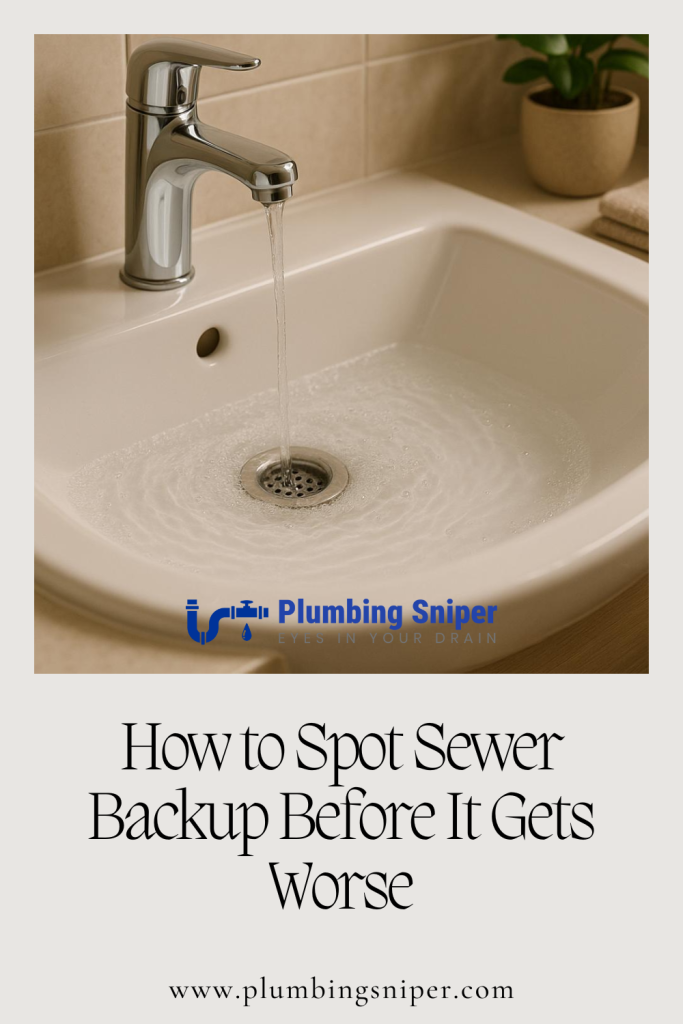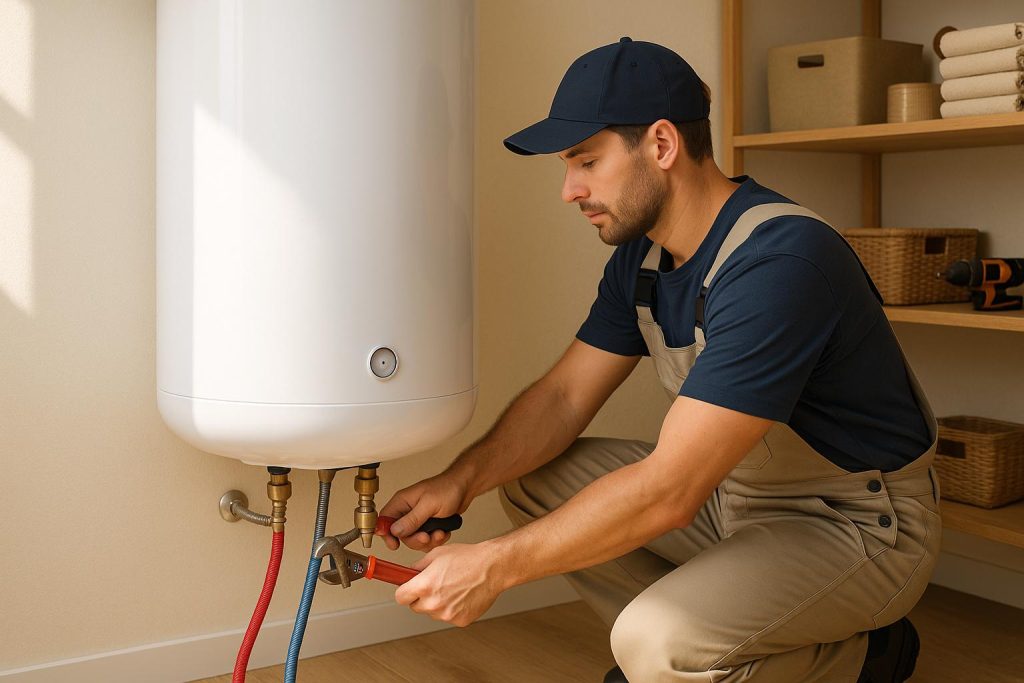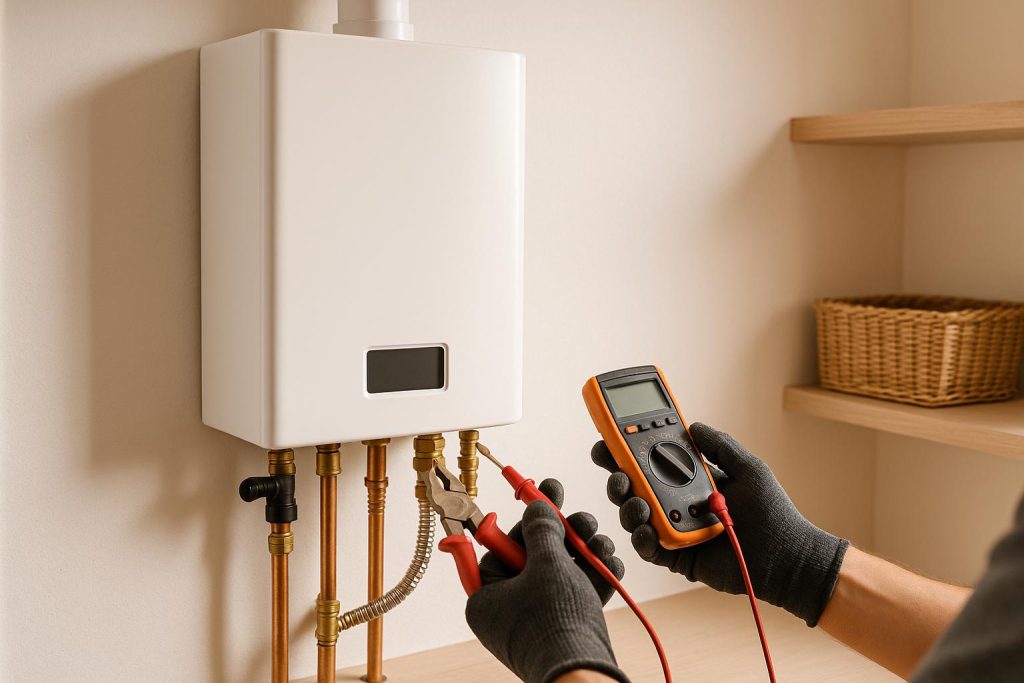Sewer backups are a messy and costly problem that can damage your home and health. Catching the warning signs early can save you thousands in repairs and prevent exposure to harmful bacteria. Here’s what to watch for:
- Multiple drains clogging simultaneously: A major red flag for a main sewer line blockage.
- Odd gurgling noises: Trapped air in pipes often signals a backup.
- Slow drainage: When water takes too long to drain from sinks or tubs, it could indicate a partial blockage.
- Foul odors: Unpleasant smells like sulfur or sewage mean wastewater isn’t flowing properly.
- Water backing up: Wastewater reversing into fixtures is a serious issue requiring immediate attention.
Prevention tips: Clean drains regularly, avoid flushing grease or non-flushable items, and schedule annual inspections. Installing a sewer backflow preventer and addressing tree root interference can also protect your home. If a backup occurs, stop using water immediately and call a professional plumber.
Why act fast? Routine maintenance costs $150–$800, while major repairs can soar to $25,000. Early detection saves money and keeps your family safe from health risks. Don’t wait – spot the signs and take action today.
How To Identify The First Signs of a Sewer Back Up
Warning Signs of Sewer Backup
Spotting the early signs of a sewer backup can save you from costly repairs and potential health hazards. Plumbing experts emphasize the importance of catching these issues early to prevent severe home damage and risks to your well-being.
Here’s what to look out for. Each warning sign provides valuable insight into potential sewer problems.
Multiple Drains Clogged at the Same Time
If several drains in your home clog all at once, it’s likely pointing to a blockage in the main sewer line rather than isolated pipe issues. A single clogged drain is pretty normal, but when you see multiple clogs – especially if flushing a toilet causes water to back up into a tub or shower – it’s a major red flag for a main sewer line problem.
Odd Noises from Drains
Gurgling or bubbling sounds coming from your toilets, sinks, or other drains could mean air is trapped in the sewer lines due to wastewater backing up. Apex Plumbing, Heating, and Air Pros explains it well:
When wastewater is backing up into the home, there may be air pockets in the sewer lines that will cause gurgling or bubbling sounds to come from the drain.
These strange noises often signal a blockage or even a break in your sewer system.
Slow Draining Water
When water takes longer than usual to drain from sinks, tubs, or showers, it’s a sign of a partial blockage that could be getting worse. This is especially concerning if the problem affects multiple fixtures in your home.
Unpleasant Sewer Smells
Your sewer line is designed to keep odors contained. If you start noticing foul smells – like sulfur, mold, or raw sewage – it’s a sign that wastewater isn’t flowing as it should. Palo Alto Plumbing highlights this issue:
Bad smells are one of the earliest signs of a sewer problem.
These odors can become strong enough to cling to furniture or clothing. If this happens, it’s time to call in a professional for an inspection.
Water Backing Up Through Fixtures
Backflow is one of the most obvious signs of a sewer backup. This occurs when wastewater reverses direction – like when flushing the toilet causes water to bubble up in the bathtub or running the washing machine leads to sewage appearing in a basement floor drain. Such cross-contamination points to a serious blockage or damage in the main sewer line. Acting quickly by contacting a plumber can help you avoid extensive damage and reduce repair costs.
Identifying these signs early can make all the difference in keeping your home safe and functional.
How to Prevent Sewer Backup
Catching sewer issues early and taking preventive steps can save you from hefty repair costs and potential health risks. As the Lamont Public Utility District emphasizes:
Grease is the most frequent cause of sewer problems.
By understanding this and adopting key prevention strategies, you can help protect your home from the warning signs of sewer troubles.
Keep Drains Clean
Routine maintenance is key to keeping your drains in good shape. Aim to inspect and clean your sewer lines twice a year to identify and address any problems before they escalate.
- Dispose of grease and food scraps properly: Instead of washing them down the drain, throw them in the trash.
- Use drain screens: Place screens over sink, shower, and tub openings to catch hair and debris before they can clog your pipes.
- Flush drains regularly: Once a week, pour hot water mixed with baking soda or vinegar down your drains to clear minor buildup. For deeper cleaning, use enzyme-based cleaners monthly to break down organic debris without harming your pipes.
- Be mindful of what you flush: Stick to flushing only toilet paper. Items like wet wipes, feminine hygiene products, and cotton swabs should go in the trash.
- Schedule professional cleanings: An annual rooter cleaning by a plumber can help keep your system running smoothly.
Combining regular cleaning with physical safeguards ensures a more comprehensive approach to sewer maintenance.
Install a Sewer Backflow Preventer
A sewer backflow preventer is a device that prevents wastewater from flowing back into your home during heavy storms or flooding, when municipal systems might be overwhelmed.
A sewage backflow preventer is an essential device that can protect your home and property from sewage backups, water damage, and the spread of disease.
Installing this device typically involves identifying the best spot in your sewer line – usually before any fixtures – and excavating to access the pipe. A licensed plumber will then install the valve assembly and connect it securely to your sewer line.
Professional installation is critical. A qualified plumber will ensure the device is placed in a location that allows for easy inspection, maintenance, and cleaning, ideally outside your home. To keep it functioning properly, schedule periodic inspections and tests. For added peace of mind, consider installing a sewer backup alarm.
Beyond preventing backups, backflow preventers help shield your family from harmful pathogens found in raw sewage, keep unpleasant odors at bay, and protect your property from water damage. Plus, having one installed can even boost your property value by showing you’ve taken proactive measures to safeguard your home.
Stop Tree Root Problems
Tree roots are a common culprit behind sewer line damage. They naturally seek out moisture and can penetrate older sewer lines made of materials like clay, cast iron, or concrete through cracks or loose joints.
To minimize the risk of root intrusion:
- Plan your landscaping carefully: Avoid planting trees with aggressive root systems near sewer lines. Trees within 65 feet of a sewer line are especially likely to cause issues. A landscaper can help you select plants that are less likely to interfere with your pipes.
- Install root barriers: Protective barriers made of metal or plastic can create a buffer zone around your sewer lines without harming nearby plants.
- Schedule regular inspections: Annual sewer camera inspections can detect minor root intrusions before they turn into major problems. Spring and early summer are peak growth times for roots, so be extra vigilant during these seasons.
If you notice slow drains or gurgling noises, it could be a sign of root intrusion. In such cases, hire a plumber to inspect your sewer line with a camera, confirm the presence of roots, and assess any damage. Regular drain cleaning also helps by removing debris that might encourage root growth.
sbb-itb-33e6ed9
What to Do During a Sewer Backup Emergency
Acting quickly and staying calm can make a big difference when dealing with a sewer backup. Here’s how to protect your home and keep your family safe.
Call a Professional Plumber
Once you confirm a sewer backup, your first call should be to a licensed plumber. Waiting too long to get professional help can lead to serious damage to your floors, walls, and belongings. Also, make sure to stop all water usage in your home to avoid making the backup worse.
Stop Using Drains and Toilets
As soon as you notice a sewer backup, stop using any water fixtures – this includes toilets, sinks, showers, washing machines, and dishwashers. Restoration 1 of Cary emphasizes:
Refrain from using your toilets and kitchen and bathroom drains the moment you notice backups. Doing so prevents more wastewater from coming back up and adding to the mess inside your home.
Turn off the water valves connected to the affected areas immediately. If contaminated water starts spreading, evacuate the area and call for assistance. Avoid trying DIY fixes that could harm your plumbing further.
Avoid Chemical Cleaners
It might be tempting to use chemical drain cleaners, but they can actually make things worse. These products often contain harsh chemicals like lye or sulfuric acid, which can damage your pipes and release harmful fumes. Plus, they rarely address the root cause of the problem and can even aggravate the situation.
Tony’s Drain & Sewer Cleaning offers this advice:
Chemical drain cleaners may seem like a quick fix, but they can pose serious risks to your health and your home. By using safer alternatives and practicing good drain maintenance, you can keep your plumbing in top shape without putting yourself or your pipes in danger.
Instead of turning to chemicals, stop using water and call a professional. For minor backups, you could try using a plunger, but only if raw sewage isn’t actively coming back into your home. The risks to your plumbing, health, and the environment simply aren’t worth it.
Why Early Detection Matters
Catching sewer problems early can save you from both financial strain and health risks. Sewer backups, which already impact 1 in 5 households, are increasing at a rate of 3% annually.
From a financial perspective, the benefits are clear. Routine sewer cleaning typically costs between $150 and $800, while a sewer scope inspection ranges from $250 to $500. Compare that to the staggering $3,000 to $25,000 price tag for major sewer repairs, and the importance of early action becomes obvious.
Health risks are another major concern. Sewage backups expose your home to harmful bacteria, viruses, parasites, and chemicals, contributing to nearly 2 million illnesses each year. These include stomach flu, hepatitis, skin infections, and respiratory problems.
As wastewater expert Jeanie Lentz explains, “Sewer backups can be triggered by flushing items that should not be flushed – fats, oils, grease, wipes, etc.”. This highlights the importance of proper disposal habits and regular maintenance, especially since grease and debris are responsible for 80% of sewer backups.
Neglecting these issues can lead to severe consequences. Delays in addressing backups can cause extensive property damage, affecting everything from flooring to the foundation. Mold growth often follows, turning what could have been a minor repair into a costly restoration project. Scheduling sewer inspections every one to two years and addressing problems promptly can safeguard both your home and your health.
FAQs
What health risks can a sewer backup cause, and how can you stay safe?
A sewer backup can expose you to dangerous bacteria, viruses, and toxic gases, which can lead to various health problems. These risks include gastrointestinal issues, skin irritations, respiratory troubles, and even infections affecting the eyes or ears. In more severe situations, exposure to gases like hydrogen sulfide may result in dizziness, nausea, or other serious health complications.
To protect yourself, avoid any direct contact with contaminated water. Use protective gear such as gloves, boots, and masks when dealing with the cleanup. Make sure the area is well-ventilated, and if possible, hire a professional to handle the cleanup thoroughly. Acting quickly can help minimize health risks and prevent additional damage.
What is a sewer backflow preventer, and should every home have one?
A sewer backflow preventer is a one-way valve that plays a crucial role in keeping sewage from flowing back into your home. This can happen during heavy rains, sewer line blockages, or storm surges. Essentially, it acts as a protective barrier for your plumbing system, helping to prevent contaminated water from causing property damage or posing health risks.
If you live in an area that frequently experiences flooding or sewer backups, installing a backflow preventer is worth considering. While it might not be necessary for every home, it can help you avoid expensive repairs and unsanitary situations. To make the best decision for your property, consider consulting a plumbing expert.
How can I prevent tree roots from damaging my sewer lines?
To keep your sewer lines safe from tree root damage, start by planting trees at least 10 feet away from the lines. This simple step reduces the likelihood of roots reaching and intruding into your pipes. You can also use root barriers – made from materials like metal, plastic, or stone – to steer roots away from your sewer system. Upgrading old or damaged pipes to leak-resistant plastic ones is another effective way to prevent roots from being drawn to moisture.
Routine inspections and maintenance play a key role in spotting early signs of root intrusion before it leads to major issues. If you’re unsure about the health of your sewer lines, reaching out to a plumbing professional for advice or periodic checks can help you avoid expensive repairs later on.






